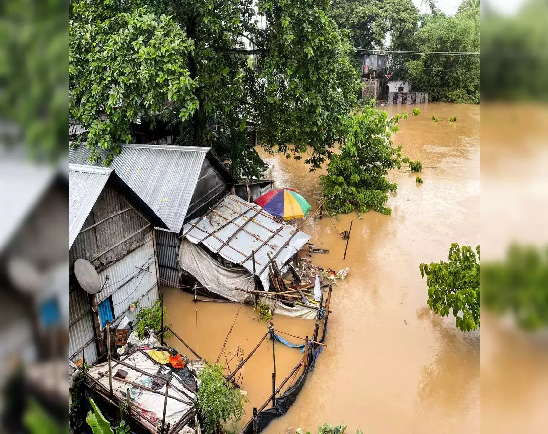INDIA-BANGLADESH RELATIONS AND THE ISSUE OF FLOODS
Context:
The recent floods in eastern Bangladesh have sparked protests, with some groups blaming India for the deluge. These accusations are linked to the Dumbur dam on the Gumti River in Tripura, India. However, the Ministry of External Affairs (MEA) of India has categorically denied that the floods in Bangladesh were caused by the dam, stating that it has been “auto-releasing” water due to heavy rainfall, a standard procedure for dam safety. This issue has escalated to the point of security concerns for the Indian High Commission in Dhaka.
Source : ET
Understanding the Shared River Dynamics:
India and Bangladesh share 54 common rivers, making water management a significant component of their bilateral relations. Rivers like the Gumti, which flows through Tripura and into Bangladesh, are essential for both countries’ water needs and ecological balance. The transboundary nature of these rivers means that actions on one side can have repercussions on the other, necessitating cooperation and understanding.
Hydrological Factors:
The floods in Bangladesh are primarily due to heavy rainfall over the catchment areas of the Gumti River, affecting both Tripura and Bangladesh. The auto-release mechanism of the Dumbur dam, which ensures the dam’s safety by preventing overflow, was activated due to these rains. It is important to note that such mechanisms are a standard feature in hydropower dams worldwide, designed to handle excess water safely.
Diplomatic Sensitivities:
The MEA’s statement highlights that the floods are a shared problem, not one caused by unilateral actions. This diplomatic stance emphasizes the importance of cooperative management of shared water resources. Indian High Commissioner to Bangladesh, Pranay Verma’s meeting with Mohammad Yunus, Chief Adviser to the interim government of Bangladesh, underscores India’s concern about the situation and the need for dialogue and collaboration.
Security Concerns:
The protests in Bangladesh, partly fueled by anti-Indian sentiments, have raised concerns about the safety of Indian diplomatic missions. These protests coincide with broader anti-government demonstrations in Bangladesh, where issues like water management can become politicized and leverage nationalist sentiments.
Policy Implications and Recommendations:
- Strengthening Bilateral Mechanisms: There is a need to enhance existing bilateral mechanisms for water sharing and flood management. Joint monitoring stations, real-time data sharing, and early warning systems can help both countries prepare better for such natural events.
- Public Awareness and Communication: Governments must ensure transparent communication with the public regarding the causes of floods and the actions being taken to mitigate them. Misconceptions and misinformation can lead to unnecessary tension and conflict.
- Integrated Water Resource Management (IWRM): A holistic approach to managing shared river basins, considering both upstream and downstream impacts, is crucial. This approach should include environmental considerations, equitable water distribution, and sustainable development.
- Security Measures: In light of the heightened security threats, diplomatic missions must be provided with adequate protection. Both countries should work together to ensure that diplomatic personnel are safe and can operate without fear of harassment or violence.
- Regional Cooperation: Beyond bilateral efforts, regional cooperation frameworks involving other South Asian countries sharing common rivers can be explored. Organizations like the South Asian Association for Regional Cooperation (SAARC) can play a role in fostering cooperation on water-related issues.
Conclusion:
The flooding of common rivers like the Gumti is a shared challenge for India and Bangladesh. While natural events like heavy rains are the primary cause, effective management and cooperation can minimize the impact on human lives and property. Diplomacy, transparent communication, and mutual respect for each other’s concerns will be the key to resolving such issues amicably. For UPSC aspirants, this case study is a pertinent example of the complexities of international relations, environmental management, and the importance of regional cooperation in South Asia.
Source: Hindu




